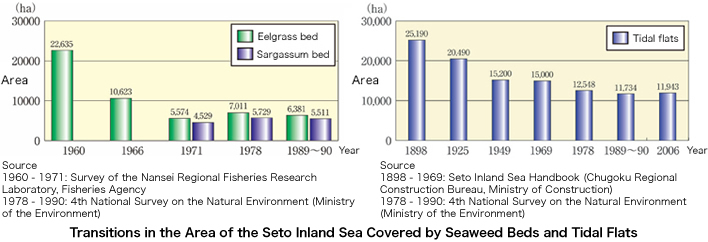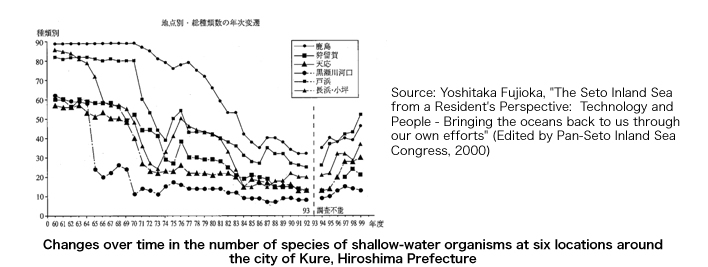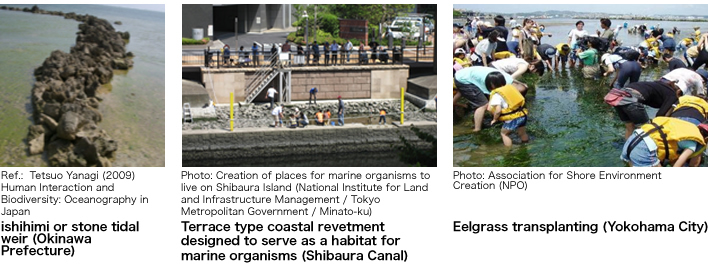Sato-umi and Ecosystems
![]()
Once there were many seaweed beds and tidal flats in Japanese coastal zones. The seaweed beds were places where konbu, wakame and other seaweeds and Zostera (eelgrass) and other marine plants flourished. These played an important role in purifying water quality and bottom sediment, and they provided spawning grounds and habitats for fish, shellfish and other creatures and hiding places for young and larval fish and so on.
Tidal flats are areas of sand and mud that emerge from and are submerged by the sea in accordance with the ebb and flow of the tides. The bivalves, benthic organisms and other creatures that live in tidal flats break down the substances that flow into the tidal flats from land, and as a result they play a crucial function in purifying seawater.
Moreover, many fish, waterfowl and other creatures gather to feed on the organisms that live in the tidal flats, and so these areas play a crucial role in the ecosystem and in substance circulation. Seaweed beds, tidal flats and other shallows are also precious locations where human beings can come in contact with the sea. In the past, people came to these places to gather fish and shellfish, and to collect eelgrass and the like to use as fertilizer and fuel.

During Japan's period of high-level economic growth, many seaweed beds and tidal flats vanished as a result of reclamation accompanying development in coastal zones. In the Seto Inland Sea, approximately 70% of the eelgrass beds disappeared from 1960 to 1990, while some 50% of tidal flats were lost between 1900 and 2006.
As a result of the reduction in tidal flats and seaweed beds and seawater pollution, the fishing catch in the Seto Inland Sea has continued to decline following the peak that occurred around the year 1980. The number of shallow-water species in the area around the city of Kure, Hiroshima Prefecture has also declined starting around 1960.



A variety of efforts are underway in various locations to prevent this kind of ecosystem deterioration and increase biological productivity and biodiversity.
In the past, a traditional fishing apparatus known as ishihimi or stone tidal weir was employed in the Ariake Sea, as well as in Okinawa, Korea and other places. A stone wall made of rocks, coral and the like was constructed at locations with tidal flats, coral reefs and other shoals where the tidal variations at high and low tides are great, in order to prevent the fish carried there from the ocean at high tide from escaping at low tide. The gaps in these stone walls are used as hiding places and habitats by various marine organisms, and fish gather in these locations to feed on these organisms. As a result, biodiversity is created. Other efforts are also underway in urban and other areas, such as creating eelgrass beds and providing artificial tidal flats and shallows in the canals and manmade embankments that have been created as a result of reclamation and development.

Maintaining Biodiversity and Biological Productivity through Human Efforts
When Acanthaster planci (crown-of-thorns starfish) breed in large numbers, they eat coral and bring about the death of coral reefs. In Okinawa and Wakayama, divers are taking action to eradicate these starfish in order to protect the coral reefs. In recent years, a phenomenon known as isoyake or rocky shore denudation, in which the seaweed beds wither and die, has occurred in various locations. Ecklonia cava Kjellman and other types of seaweed are being planted in order to prevent this from happening. An effort is also underway to remove sea urchins and seaweed-eating fish such as rabbitfish to prevent them from damaging the seaweed beds.
In addition, fishery operators are also acting autonomously to establish "no fishing" zones and seasons in order to preserve biological resources. For example, the area shoreward from the torii (gate to the shrine) at Itsukushima Shrine in Hiroshima Prefecture has been made off limits to fishing. These and other human management efforts are also one way of creating the Sato-umi that play such a crucial role in preserving nature and marine life.













